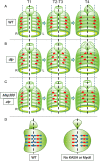Collective nuclear behavior shapes bilateral nuclear symmetry for subsequent left-right asymmetric morphogenesis in Drosophila
- PMID: 34097729
- PMCID: PMC8126412
- DOI: 10.1242/dev.198507
Collective nuclear behavior shapes bilateral nuclear symmetry for subsequent left-right asymmetric morphogenesis in Drosophila
Abstract
Proper organ development often requires nuclei to move to a specific position within the cell. To determine how nuclear positioning affects left-right (LR) development in the Drosophila anterior midgut (AMG), we developed a surface-modeling method to measure and describe nuclear behavior at stages 13-14, captured in three-dimensional time-lapse movies. We describe the distinctive positioning and a novel collective nuclear behavior by which nuclei align LR symmetrically along the anterior-posterior axis in the visceral muscles that overlie the midgut and are responsible for the LR-asymmetric development of this organ. Wnt4 signaling is crucial for the collective behavior and proper positioning of the nuclei, as are myosin II and the LINC complex, without which the nuclei fail to align LR symmetrically. The LR-symmetric positioning of the nuclei is important for the subsequent LR-asymmetric development of the AMG. We propose that the bilaterally symmetrical positioning of these nuclei may be mechanically coupled with subsequent LR-asymmetric morphogenesis.
Keywords: 3D reconstruction; Actin; Development; Image processing; Nucleus.
© 2021. Published by The Company of Biologists Ltd.
Conflict of interest statement
Competing interests The authors declare no competing or financial interests.
Figures






Similar articles
-
Left-right asymmetric morphogenesis of the anterior midgut depends on the activation of a non-muscle myosin II in Drosophila.Dev Biol. 2010 Aug 15;344(2):693-706. doi: 10.1016/j.ydbio.2010.05.501. Epub 2010 May 27. Dev Biol. 2010. PMID: 20553709
-
Canonical Wnt signaling in the visceral muscle is required for left-right asymmetric development of the Drosophila midgut.Mech Dev. 2012 Jan-Feb;128(11-12):625-39. doi: 10.1016/j.mod.2011.12.002. Epub 2011 Dec 17. Mech Dev. 2012. PMID: 22198363
-
Roles of type I myosins in Drosophila handedness.Fly (Austin). 2007 Sep-Oct;1(5):287-90. doi: 10.4161/fly.5252. Epub 2007 Sep 4. Fly (Austin). 2007. PMID: 18836316
-
The myosin ID pathway and left-right asymmetry in Drosophila.Genesis. 2014 Jun;52(6):471-80. doi: 10.1002/dvg.22763. Epub 2014 Mar 17. Genesis. 2014. PMID: 24585718 Review.
-
The twists and turns of left-right asymmetric gut morphogenesis.Development. 2020 Oct 12;147(19):dev187583. doi: 10.1242/dev.187583. Development. 2020. PMID: 33046455 Free PMC article. Review.
Cited by
-
Regulation of organelle size and organization during development.Semin Cell Dev Biol. 2023 Jan 15;133:53-64. doi: 10.1016/j.semcdb.2022.02.002. Epub 2022 Feb 8. Semin Cell Dev Biol. 2023. PMID: 35148938 Free PMC article. Review.
-
The Drosophila AWP1 ortholog Doctor No regulates JAK/STAT signaling for left-right asymmetry in the gut by promoting receptor endocytosis.Development. 2023 Mar 15;150(6):dev201224. doi: 10.1242/dev.201224. Epub 2023 Mar 21. Development. 2023. PMID: 36861793 Free PMC article.
References
Publication types
MeSH terms
Substances
LinkOut - more resources
Full Text Sources
Molecular Biology Databases
Research Materials

